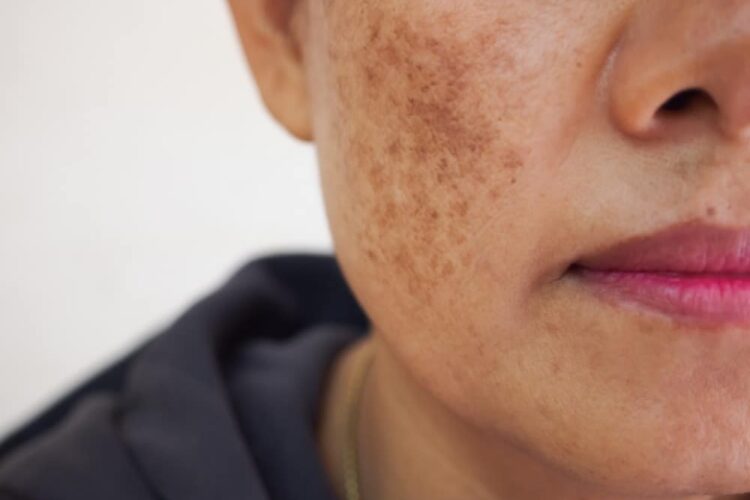Melasma, commonly referred to as the “mask of pregnancy”, is a widespread skin condition that results in brown or grayish-brown patches predominantly on the face. It’s most often seen on the cheeks, bridge of the nose, forehead, chin, and above the upper lip but can also appear on other parts of the body that get a lot of sun exposure, such as the forearms and neck.
Formation and Causes of Melasma
Melasma forms when melanocytes, the skin cells responsible for producing melanin, produce excessive amounts of pigment. The exact cause of the overproduction is still under research, but several factors contribute to its onset. These include sun exposure, as ultraviolet (UV) light can increase melanin production; hormonal changes, particularly in pregnant women, which is why melasma is sometimes called the “mask of pregnancy”; and certain skincare products or cosmetics that can irritate the skin and result in increased melanin production.
Types of Melasma and Skin Hyperpigmentation
Melasma can be classified into three main types based on the depth of the pigment:
Epidermal Melasma: This type features dark spots that have a well-defined border. The affected areas appear darker brown and are usually responsive to treatments since the pigmentation is on the outermost layer of the skin.
Dermal Melasma: Characterized by blue-gray patches, this form of melasma is more challenging to treat because the pigmentation is located deeper within the skin.
Mixed Melasma: As the name suggests, this type combines features of both epidermal and dermal melasma, featuring both brown and blue-gray patches.
Besides melasma, other types of skin hyperpigmentation include freckles, sunspots, post-inflammatory hyperpigmentation, and age spots, all of which have distinct causes and appearances.
Non-Surgical Melasma Treatment in Singapore
Singapore, with its tropical climate and high UV exposure, has seen an increase in the number of melasma cases over the years. Fortunately, the country is also at the forefront of dermatological advances, offering various non-surgical melasma treatments.
Topical Treatments
The first line of treatment usually involves topical applications. These include hydroquinone, which inhibits the enzyme tyrosinase and, thus, melanin production; tretinoin, which helps in skin turnover and lightening the patches; and corticosteroids, which reduce inflammation and can enhance the efficacy of other topical treatments. Other active ingredients that can assist are glycolic acid, azelaic acid, and kojic acid.
Procedural Treatments
For cases resistant to topical treatments, or for faster results, procedural interventions might be recommended. Chemical peels, microdermabrasion, and certain lasers can be used. However, special emphasis has been placed on the Pico laser in recent times.
The Pico Laser Advantage
The Pico laser, a type of picosecond laser, is an innovative non-surgical melasma treatment in Singapore. Unlike traditional lasers that rely on intense heat energy, the Pico laser delivers energy in ultra-short bursts, shattering the pigment into tiny particles without causing significant heat damage to the surrounding skin. This means a reduced risk of post-inflammatory hyperpigmentation, especially in darker skin tones. Pico lasers not only help in lightening melasma patches but also improve skin texture and reduce the appearance of pores. It is a preferred option for many due to its efficacy and minimal downtime.
In conclusion, while melasma remains a challenging skin condition, advances in non-surgical treatments, especially in Singapore, offer hope to those affected. The combination of topical treatments, advanced procedures, and especially the revolutionary Pico laser, ensures that individuals have multiple avenues to regain their skin’s natural beauty and confidence. If considering any treatment, always consult with a dermatologist to ensure the best care tailored to individual needs.

